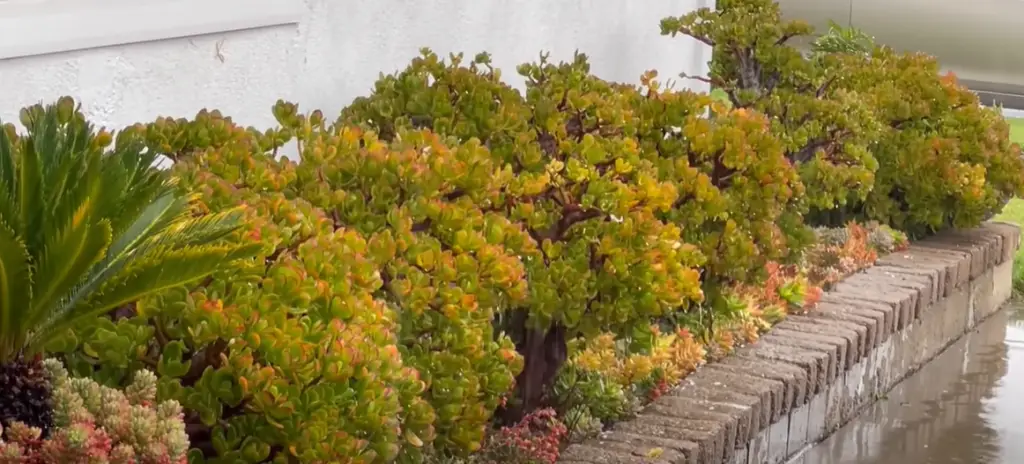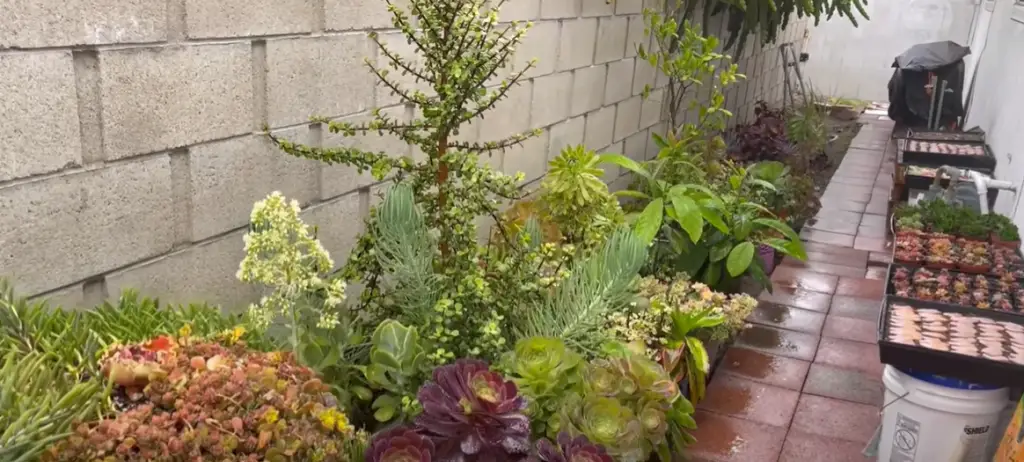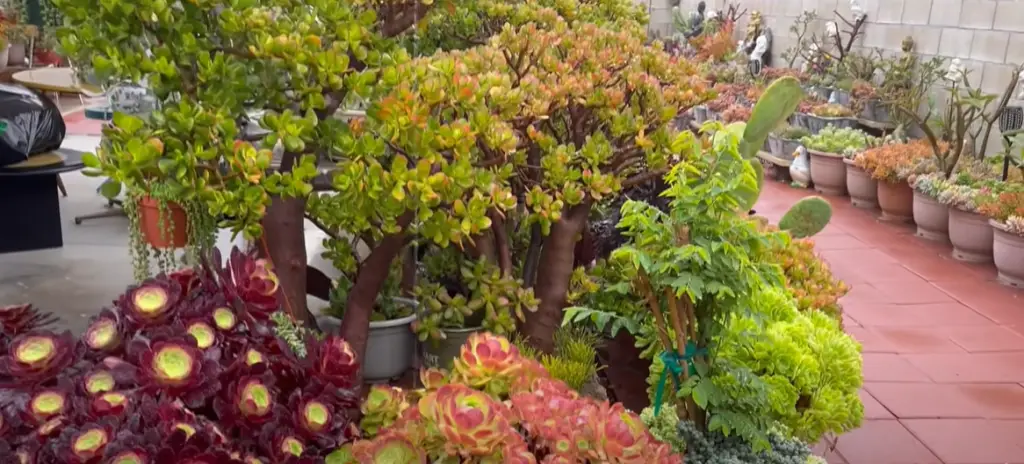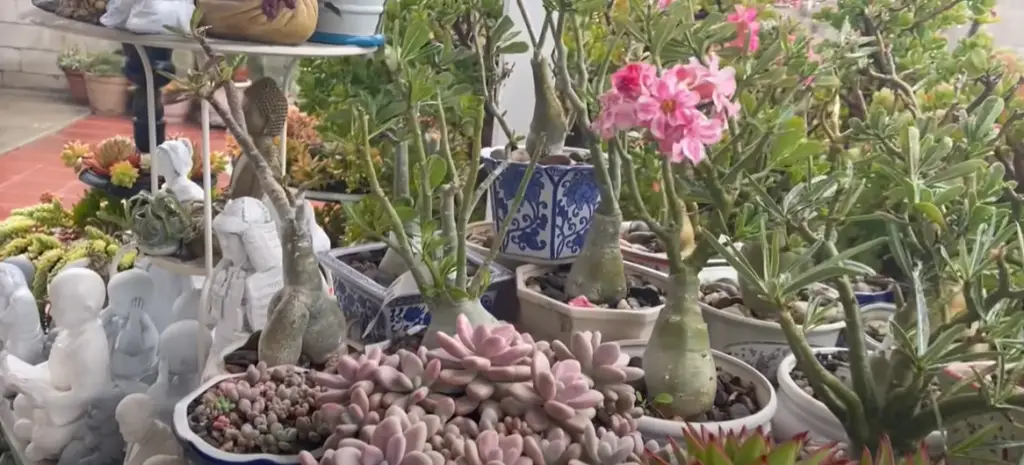If you’re reading this, chances are you either have a succulent garden or you’re thinking of creating one. Succulents are some of the most popular plants in the world right now, and for good reason! They’re easy to care for, come in a variety of shapes and sizes, and add a touch of natural beauty to any home or garden. This article will answer some common questions about succulent gardens and offer tips on how to create your very own masterpiece!
What are succulents?
Succulents are plants that store water in their leaves, stems, or roots. They originate from arid and semi-arid regions of the world, where they adapted to survive long periods of drought. Succulents require very little water and care, making them perfect for busy lifestyles. In fact, many succulent varieties can go weeks without needing any attention!
Succulents come in a wide variety of shapes and sizes ranging from small houseplants to large outdoor shrubs. They also come in an array of colors including green, blue, purple, pink, and yellow. Succulents make great gifts or decorations for any home or garden and can look amazing when paired with other plants or items. With just a little bit of care and attention, your succulents can thrive for years [1]!

Types of Succulents
Succulents come in many shapes, sizes, and colors. Some of the most popular types include:
Cacti: These are the classic succulent family and come in a wide variety of shapes, sizes, textures, and colors. They are well adapted to dry climates and can store a lot of water in their stems or leaves.
Sedums: Some sedums look like small shrubs while others resemble thick mats. The leaves may be either green or blue depending on the species.
Echeverias: These succulents form rosettes with tight clusters of colorful leaves. They are often robust when grown in bright light but need protection from freezing temperatures.
Kalanchoes: Kalanchoe plants feature glossy foliage that may be patterned or plain colored depending on species. They prefer lots of suns and can tolerate drought [2].
How to lay out a succulent garden?
Creating a succulent garden can be as easy as planting your favorite species in a pot or container of choice. However, if you want to create an aesthetically pleasing and functional garden, then it’s important to plan out the layout carefully. Here are some tips for creating the perfect succulent garden:
Choose the right location – When picking a spot for your succulent garden, find one with access to plenty of sunlight and good drainage. This will help ensure that your plants get enough daylight and are not sitting in standing water.
Select suitable containers – Succulents thrive best when planted in well-draining soil, so selecting appropriate containers is essential. Opt for pots with good drainage holes at the bottom, or use hanging containers for a more vertical display.
Prep your soil – Before planting, mix up a specially designed cactus and succulent potting mix with some extra organic matter, such as compost. This will help retain moisture and provide essential nutrition to your plants.
Arrange your design – Next comes the fun part! Lay out your succulents in groups and experiment with different heights, shapes, and colors to create an attractive landscape. Be sure to leave enough space between each plant so they have room to grow.
Water regularly – Keep an eye on your succulents’ water needs and adjust accordingly based on their growth rate and levels of sunlight exposure. Regular watering is essential in order to keep your succulents healthy and flourishing [3].

Bring in bold textures with stylish succulent garden ideas
Combine succulents with cacti for color and texture
Succulent gardens are an easy and stylish way to bring life and texture into your home. They come in a variety of colors, shapes, sizes, and textures – so you can mix and match succulents with cacti to create a unique garden that reflects your individual style. When it comes to combining succulents with cacti, there are virtually no rules; just go with what works best for the look you’re going for! To create an eye-catching display, try using different containers such as glass jars, hanging baskets, or ceramic pots.
Give a nautical twist to your succulents
If you’re looking for a creative way to display your succulents, why not try giving them a nautical twist? Consider adding sea shells, pieces of driftwood, or even small boats as decorative accents in your succulent garden. This is an especially great idea if you live near a beach or love the ocean – it will bring that coastal charm indoors!
Create a living wall with succulents and air plants
Living walls are perfect if you want to add more greenery to your home without taking up too much space. You can create one out of almost any type of plant, but succulents and air plants work best since they require little maintenance and don’t need to be watered often. To make a living wall, simply attach small pots or planters to a board. Then fill them with soil and your chosen plants – voila! You can hang it on a wall in your home for an instant pop of color and texture.
Add some height with potted succulents
If you’re looking for a way to add some drama and interest to your succulent garden, try adding some tall potted succulents. They’ll instantly add height to the display, while still keeping the focus on your green beauties. Plus, if you don’t want to stick with just one kind of plant, you can mix and match different types of potted succulents, cacti, and air plants for a truly unique look.
Fill in the cracks with tiny succulents
For a truly unique look, consider filling in some of your garden’s nooks and crannies with tiny succulents. This is a great way to create an interesting texture – plus, it will add a lot of personality to your space. Just be sure not to overcrowd the area, as too many plants can quickly become overwhelming.
Display in rustic containers
If you want to add some rustic charm to your succulent garden, why not try displaying them in rustic containers? Woven baskets, terracotta planters, and wooden boxes are all great options for creating a unique display. Plus, they’ll help give your garden that extra special touch.

Go bold with blue agave plants
Blue agave is a beautiful and unique plant that will add a vibrant pop of color to your succulent garden. It’s perfect for adding some wow-factor, and it will also attract hummingbirds and butterflies if you display it outdoors. To make the most of this gorgeous plant, try pairing it with other bright succulents like cacti or aloe vera for an eye-catching display.
Create an indoor jungle with mixed succulents
If you want to create an indoor oasis full of lush greenery, consider combining different types of succulents in one big container. You can mix small and large plants, as well as colorful varieties like jade plants or hens-and-chicks. And if you want your succulent jungle to look even lusher, add a few ferns or ivies – they’ll bring some added texture and depth to the display.
Grow edible succulents
If you’re feeling adventurous, why not try growing some edible succulents in your garden? Nopales (prickly pear cactus pads) are a great option if you want to add some spice to your dishes. Aloe vera is another popular choice – it can be used for both culinary and medicinal purposes. And if you’re looking for something even more unique, consider planting some spiky dragon fruit cacti or jicama – they’ll make a great addition to any meal!
Create a wellness moment with aloe vera
Aloe vera is not only a great addition to your succulent garden – it’s also a fantastic way to create a wellness moment in your home. Its sap-filled leaves have anti-inflammatory and healing properties, so you can tear off pieces of the plant and apply them directly to minor cuts and burns. Plus, it smells amazing! So be sure to include some aloe vera in your indoor or outdoor succulent garden for an extra dose of relaxation.
Incorporate succulents into hard landscaping
Succulents are not just for container gardens – you can also incorporate them into hard landscaping projects. For example, try planting a few succulent varieties in the gaps between rocks and stones in your garden’s pathways or around water features. This is an easy way to add texture and color without having to rely on traditional potted plants.
Add some drama with dramatic succulents
If you want your succulent garden to really stand out, then why not include some of the more dramatic varieties? Things like giant barrel cacti, blue echeveria, and even Venus flytraps make great additions to any collection. They’ll help create a truly unique display that is sure to wow visitors.
Frame a seating area with succulents
If you want to create a cozy seating area in your garden, why not frame it with some succulent plants? This is an easy way to add some life and color to an outdoor space. Plus, it’s a great way to keep your seating area looking neat and tidy – no more overgrown grass or weeds!

Arrange your plants to create unique color patterns
When it comes to arranging your succulents, don’t be afraid to get creative. Try grouping certain varieties in order to create interesting color patterns and textures. You could even try playing around with different shapes and sizes for a more eye-catching display [4].
How to plant succulents?
Planting succulents is easier than most plants, but there are steps you should follow for the best results.
- Choose a pot that has drainage holes in the bottom and fill it with a cactus mix or well-draining soil (or create your own mix of 50% regular potting soil and 50% perlite or coarse sand).
- Make a hole in the center of the soil about twice as wide as the root ball of your plant. Place the plant into it, spreading out its roots and pressing them down gently if necessary.
- Fill in around the root ball with additional soil to cover any exposed roots and firm it lightly so that your succulent stays upright when you water it.
- Water your succulent until the soil is completely saturated and allow any excess water to drain from the pot. Succulents require very little water, so only water them when the top inch or two of soil is dry.
- Place in a sunny spot near a window and enjoy your new plant [5]!
How to care for succulents?
Potting soil
Succulents have special requirements for soil, so it’s important to use a potting mix that is designed specifically for them. Look for soils with good drainage which will help prevent your succulents from getting root rot. A good mixture should include a combination of organic matter, such as peat moss, and mineral material like pumice or perlite.
Watering
Because of their thick leaves and stems, succulents store water to survive long periods without rain or watering. This means they don’t need a lot of water in order to thrive but be sure not to underwater them either; this can lead to dehydration or other health issues. When you water your succulents, give them a good soak and then let the soil dry out completely before watering again.

Light
Succulents need plenty of light in order to grow healthy and vibrant. If you’re growing your succulent indoors, be sure it has access to bright, indirect sunlight for at least 4 hours per day. Outdoor succulents should be placed in an area that gets full sun for most of the day.
Temperature
Succulents generally prefer warm temperatures and are not tolerant of extreme cold or heat. Keep your succulents away from drafty windows or doors, as well as direct sources of heat like radiators or air conditioning units. The ideal temperature range for most varieties is between 65-75°F (18-24°C).
Fertilizer
Although succulents don’t need to be fertilized frequently, they can benefit from an occasional application of a balanced fertilizer. Choose one with a low nitrogen content and no more than 10% phosphorus or potassium. You should only fertilize your succulents during their active growing season, typically in the spring and summer months.
Pruning
Succulents may occasionally need to be pruned if they become overgrown or leggy. To do this, use clean scissors or pruning shears to remove any dead or wilted leaves. If you’re cutting back stems, make sure to leave at least two sets of leaves on each stem so the plant can regenerate.
Propagation
Succulents are very easy to propagate and can be done by taking cuttings from an existing plant. To do this, use a sharp knife or scissors to take a cutting of the stem with at least two sets of leaves attached. Then place the cutting in water or potting soil and wait for it to root before transplanting it into its own pot. With proper care, new succulents should start growing within a few weeks!
Troubleshooting
If you find that your succulents are not thriving, there may be several reasons why. Check for any signs of pests such as aphids or mealybugs, which can easily cause damage if not treated quickly. Make sure your succulents are receiving the right amount of light, water, and fertilizer, as too much or too little can cause problems. Finally, be sure to check the temperature of the room; extreme temperatures can harm your plants. If all else fails, it may be time to invest in a new variety of succulents that is better suited for your particular environment.

FAQ
How do I know what type of succulent I have?
Identifying the type of succulent you have can be a bit tricky, depending on your level of gardening knowledge. The best way to find out is by researching online for pictures and descriptions of different types of succulents. You can also visit your local nursery or garden center and ask an experienced staff member to help you identify the specific succulent you own. Additionally, some nurseries provide plant identification services that can help you accurately determine the type of succulent you have. Finally, if all else fails, take a picture of your plant and post it in a gardening forum for novice and expert growers alike – someone with more experience may be able to recognize it for you!
What is the most common succulent?
The most common succulent is the jade plant (Crassula ovata), also known as the money tree. It’s a popular choice for indoor gardens, with its glossy leaves and easy-care requirements. Other types of succulents that are widely available include aloe vera, echeveria, kalanchoe, aeoniums, sedums, and sempervivums. These plants come in various shapes and sizes and can be found in garden centers or online nurseries all over the world.
How do I care for my succulents?
Caring for succulents is relatively simple – they prefer warm climates with plenty of sunlight and need to be watered infrequently. You should wait until the soil has dried out before watering, as overwatering can cause root rot and other issues. Additionally, you should make sure that your succulents are planted in well-draining soil so excess water can escape quickly. Finally, it is important to feed them with a balanced fertilizer every few weeks to promote healthy growth. With these tips in mind, your succulents will stay happy and healthy!
What kind of succulent is for indoor?
Some of the most popular succulents for indoor use are jade plants, aloe vera, echeveria, kalanchoe, aeoniums, and sedums. These types of succulents require minimal care and can thrive in bright spots indoors. Additionally, they are easy to maintain and don’t need too much light or water to stay healthy. Just make sure that your succulent is planted in well-draining soil so excess water can escape quickly. With these tips in mind, you can easily keep a beautiful indoor garden!
Can I grow succulents from seeds?
Yes! Succulents can be grown from both seeds and cuttings. To propagate them from seeds, you can purchase pre-packaged succulent seed mixes or individual species. Then, simply sow the seeds in a pot of well-draining soil and keep them in bright, indirect sunlight. You should also lightly mist the soil with water every few days to keep it moist until the plants have established roots. Once they have grown enough, you can transplant them into your garden or indoor containers.
Do succulents need a lot of light?
When it comes to lighting for succulents, they must be exposed to plenty of bright, indirect sunlight throughout the day. If you’re growing your succulents indoors, then make sure to place them near a window where they can get at least 6-8 hours of natural light each day. Additionally, you should rotate your plants periodically to ensure even exposure on all sides. Finally, make sure to keep them away from direct sunlight as it can cause the leaves to burn and fade.

Can I grow succulents in pots?
Yes! Succulents are actually quite well suited for pot culture and can be grown indoors or outdoors. When growing them in containers, it is important to choose a container with good drainage holes and use a well-draining soil mix such as cactus mix or a combination of peat moss and sand. You should also place the pot in an area where it will get plenty of bright, indirect sunlight throughout the day.
Is it better to plant succulents in pots or ground?
It really depends on the specific type of succulent and where you live. Generally speaking, it is better to plant them in pots if you’re growing them indoors or in a location that doesn’t experience frost. If you live in an area with mild winters, then planting succulents directly into the ground can be a great option as well. Ultimately, choose whichever method will best suit your needs and provide the optimal growing conditions for your plants.
Where should I buy succulents?
Succulents are widely available at garden centers or online nurseries all over the world. Before buying, you should make sure to read up on particular species to determine their light and water requirements so that they can thrive in your home. Additionally, make sure to check the plants for signs of pests or disease before purchasing, as these can spread quickly if left untreated. With these tips in mind, you can purchase healthy succulents to start growing right away!
Where is the best place for a succulent garden?
The best place for a succulent garden is an area that receives plenty of bright, indirect light throughout the day. You can plant them in the ground or in containers, depending on where you live and your level of expertise. Additionally, make sure to choose a planting medium with good drainage capabilities so that excess water can escape quickly. Finally, don’t forget to fertilize your succulents every few weeks to promote healthy growth! With these tips in mind, you can create a beautiful and thriving succulent garden no matter where you live.
What should I do if my succulents get too much sun?
If your succulents get too much sun, then they will start to wilt and their leaves may begin to burn. If this happens, you should move them to a location with bright, indirect sunlight and then monitor the plants for any further signs of distress. Additionally, make sure to water your succulents only when the soil is completely dry, as too much moisture can cause root rot and lead to plant death. With these precautions in place, you can ensure that your succulents stay healthy and vibrant!
Can I propagate succulents?
Yes! Succulents are actually very easy to propagate via cuttings or seeds. To propagate them from cuttings, simply snip off a piece of the stem or leaf and place it into some well-draining soil. Keep the cutting in bright, indirect sunlight, and water it only when the soil is completely dry. If propagating from seed, it is important to use sterile soil and make sure that the seeds are kept at a warm temperature for them to germinate.
Useful Video: 10 Outdoor Succulent Garden designs ideas
Conclusion
Succulent gardeners can benefit from understanding the growing conditions of succulents and becoming familiar with the available different types. By implementing suitable planting methods, including soil choice, light requirements, potting and repotting techniques, watering schedules, propagation methods, and pest control solutions, they can create a thriving succulent garden or container. Having an understanding of the basics will help to ensure success in succulent gardening. With careful observation and routine maintenance of your succulents, you can enjoy many years of beautiful plants and enjoyable landscaping!
References:
- https://www.succulentsandsunshine.com/what-are-succulents/
- https://www.purewow.com/home/types-of-succulents
- https://www.lawnstarter.com/blog/landscaping/how-to-create-a-succulent-garden/
- https://www.gardeningetc.com/design/succulent-garden-ideas
- https://www.gardendesign.com/succulents/planting.html










Leave a Reply
View Comments